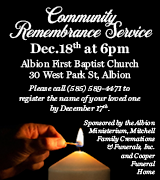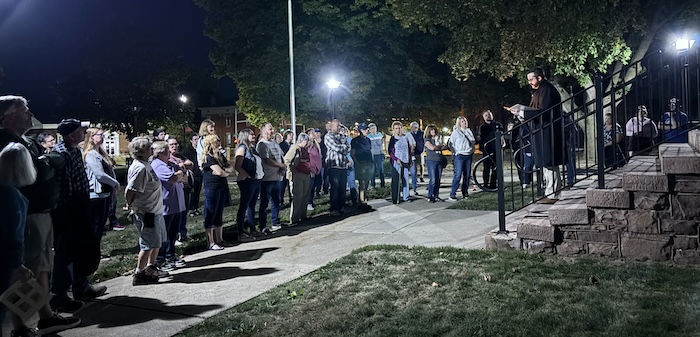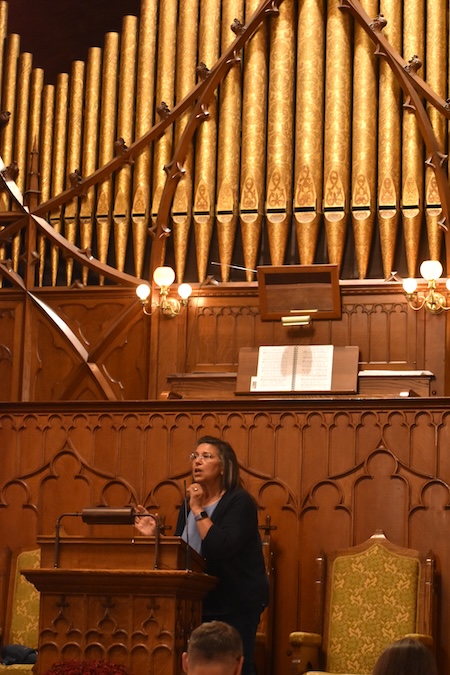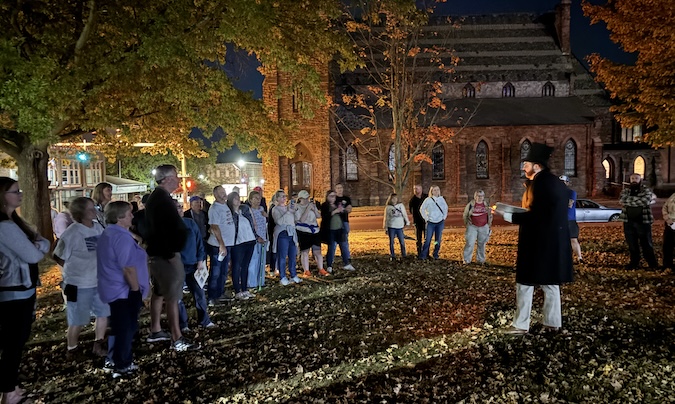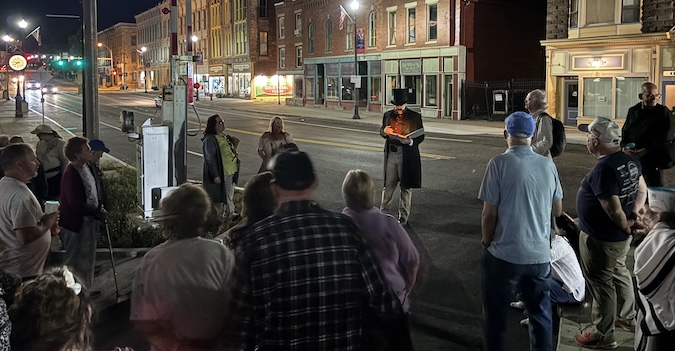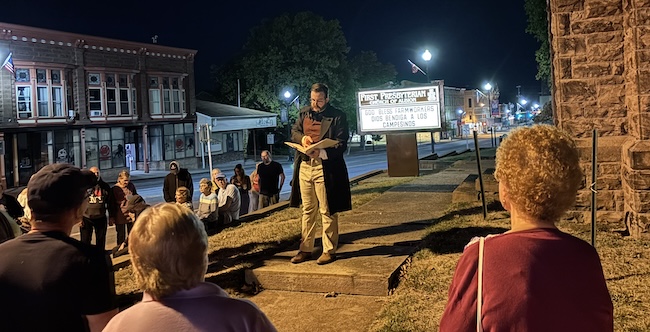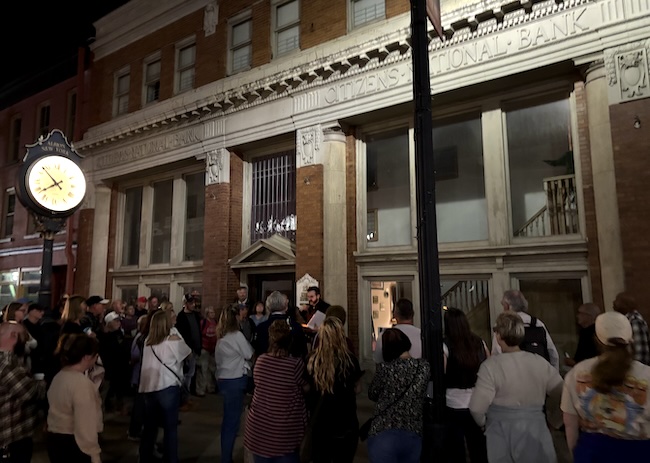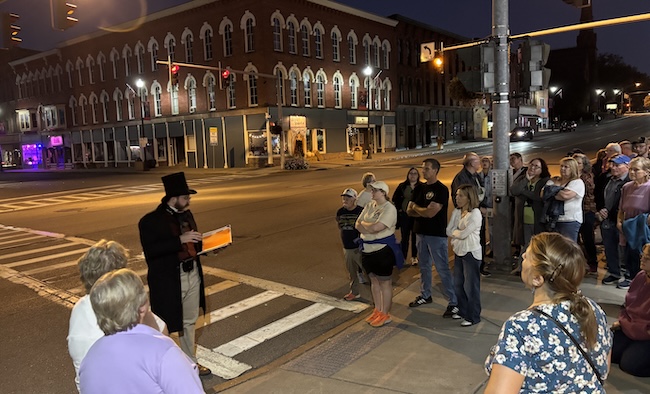Historical tour highlighted ‘murder and mayhem’ from Albion’s past
About 65 attend event which was fundraiser to restore chapel at Mount Albion Cemetery
Photos by Tom Rivers
ALBION – Matt Ballard, former Orleans County historian, led a tour on Saturday at Albion’s downtown and Courthouse Square, highlighting “Murder and Mayhem” in the community’s past.
The event was attended by about 65 people who paid $20 each for a fundraiser to restore the chapel at Mount Albion Cemetery.
Ballard is shown speaking from the steps of the County Clerks’ Building. He highlighted two famous murder trials in Albion.
George Wilson was convicted by a jury of killing his wife Alice Wilson by strangulation. George was executed in 1888 in a stockade near where the current county jail is located. That execution on June 22, 1888 was the last one in Orleans County.
Wilson was allegedly having an affair with a girl under age 18. He and his wife had five children.
Wilson protested his innocence. His neighbor provided damning testimony against Wilson. That neighbor was found guilty of committing a murder in Rochester. Ballard said some people have speculated that Wilson didn’t kill his wife. Instead, it was the neighbor.
In another high-profile case, William Lake was convicted of killing Emma Hunt who spurned his advances. She was brutally murdered on Oct. 18, 1894. Lake would be the seventh person put to death at Auburn prison by the electric chair.
There would be 55 people put to death by electric chair at Auburn prison from 1890 to 1916.
Susan Starkweather Miller, Village of Albion historian, welcomed the group for the tour which started at the Pullman Memorial Universalist Church. She is shown in front of the pulpit and church organ. Starkweather Miller has been leading the effort to restore the chapel and roof at Mount Albion Cemetery. She said the group has raised $200,000 towards at $225,000 goal.
Ballard, speaking from the lawn in front of the courthouse, shared about William Stafford, the district attorney during the Wilson murder trial. Stafford would later run for Orleans County judge and was defeated. He blamed the Baptist congregation, where he attended, for not giving him enough support.
When the Catholics were looking to build a church, Stafford sold them the property on West Park Street, with a stipulation the church building had to be so close to the street it would block the view of the Baptist Church.
Ballard stands in front of the Main Street lift bridge and tells about one of the worst tragedies in Albion’s history. On Sept. 28, 1559, there were 250 people on the bridge to watch a wirewalker over the canal. The bridge also had five horses with loaded wagons.
The bridge would tumble into the water, and 15 people would die, including several children.
Outside the Presbyterian Church, Ballard spoke about the murder of Pierpont Dyer on Christmas eve in 1859.
The wirewalker in the bridge collapse had his rope strung across the canal from the second floor of the Mansion House south towards the second floor of Dyer’s building about three months earlier.
Mr. Dyer owned a grocery store. On Christmas eve in 1859, someone entered the store and smashed Dyer in the head, killing him. One man went to trial and wasn’t convicted. The murder remains an unsolved mystery.
The Citizens National Bank used to be the First National Bank of Albion. Ballard told how Albert Warner stole about $40,000 from the bank and then fled to Canada. Warner took leadership of the bank after the previous president died from a lethal dose of arsenic.
Warner was well respected in Albion. Not only did he lead the bank, but he was the Board of Education president and leader of the fire department. But poison, betrayal and greed did in his reputation, and left many in Albion facing financial ruin.
Warner was rumored to have returned to Albion briefly, when he dressed as a woman to attend his father’s funeral at Mount Albion in 1887.
Ballard also spoke in front of the former Swan Library, which was the hoe of Roswell Burrows. Burrows amassed a fortune value at over $6 million when he died in 1879.
He established the First National Bank in Albion, a bank where the coffers were embezzled by Warner.
Ballard speaks on Main Street in front of the Five Star Bank. He highlighted a catastrophic fire on Jan. 13, 1882 that wiped out the corner. The fire started in a building for a milliner that was located behind Five Star, where its parking lot is located.
The fire of 1882 badly damaged the business district. When the fire was finally put out, Ballard said a cat emerged from the rubble.
Ballard shared other stories during the nearly two-hour presentation.




















